Read the following verbs. Pay attention to the principal forms
to succeed ( - ed; - ed) следовать за чем-либо, наследовать
to evolve ( - ed; - ed) развиваться
to derive ( - ed; - ed) происходить
to find (found; found) находить
to cause ( - ed; - ed) вызывать, являться результатом
to encourage ( - ed; - ed) ободрять, поощрять, поддерживать
to become (became; become) становиться
to assume ( - ed; - ed) принимать, предполагать
to demolish ( - ed; - ed) разрушать, сносить
3. Find proper translation to the following words:
style, classical, dominant, to characterize, order, arch, symmetrical, harmony, composition, proportion, human, perspective, expression, mass, interior, exterior, element, to formulate, column, portion, sphere, manner, façade, plan, altar, diameter, motif
4. Choose the proper English word:
1) средство a) style b) device c) composition
2) зритель a) spectator b) interior c) successor
3) ширина a) diameter b) width c) height
4) понимание a) portion b) manner c) comprehension
5) трактат a) treatise b) motif c) order
6) длина a) exterior b) length c) perspective
7) поперечный неф a) pilaster b) sphere c) transept
5. Find English equivalents for the following Russian words:
Aнепосредственный, строгий, ребристый, развиваться, вызывать, происходить, предполагать, наследовать, разрушать, поддерживать
Вto assume, to encourage, ribbed, to demolish, to derive, immediate, to succeed, to evolve, austere, to cause
6. Form all possible word combinations:
Aarchitectural Bbuildings
classical element
ancient proportions
symmetrical device
round perspective
pictorial style
linear art
basic arch
austere composition
7. Read the following word combinations and translate them into Russian:
rebirth of classical art; to derive from two sources; ancient classical buildings; to use classical orders; proportions of the human body; pictorial device of perspective; definition of architectural space; immediate and full comprehension; well–organized urban spaces; great skill; interior of buildings; linear perspective; basic element; fluted pilasters; unribbed vaults; the austere façade; the highest degree of perfection; Christian world
Reading
The Renaissance
This architectural style developed in early 15thcentury Italy during the rebirth of classical art and learning. It succeeded the Gothic as the style dominant in all of Europe after the mid 16thcentury into classicism.
 Knowledge of the classical style in architecture was derived during the Renaissance from two sources: the ancient classical buildings, particularly in Italy but also in France and Spain and the treatise “De architectura” by the Roman architect Vitruvius. Initially it was characterized by the use of the classical orders, round arches, and symmetrical composition.
Knowledge of the classical style in architecture was derived during the Renaissance from two sources: the ancient classical buildings, particularly in Italy but also in France and Spain and the treatise “De architectura” by the Roman architect Vitruvius. Initially it was characterized by the use of the classical orders, round arches, and symmetrical composition.
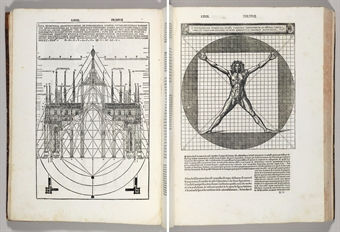 The Renaissance architects found a harmony between the proportions of the human body and those of their architecture. There was even a relationship between architectural proportions and the Renaissance pictorial device of perspective.
The Renaissance architects found a harmony between the proportions of the human body and those of their architecture. There was even a relationship between architectural proportions and the Renaissance pictorial device of perspective.
The concern[1] of these architects for proportion caused that clear, measured[2] expression and definition of architectural space and mass that differentiates the Renaissance style from the Gothic and encourages[3] in the spectator an immediate and full comprehension of the building.
Churches, palaces, gardens, and well-organized open, urban spaces are the architectural works most often associated with this time. Great skill was expressed in ordering the interior of buildings, frequently using the same motifs as had been traditionally associated with the exterior.
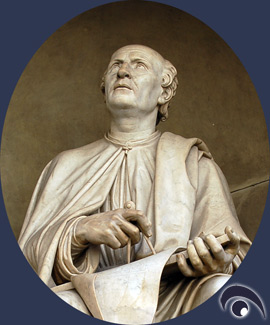 Filippo Brunelleschi[4] (1377-1446) is said to have created the Renaissance. In the early 15thcentury he formulated linear perspective, which was to become a basic element of Renaissance art. His basic vocabulary – fluted pilasters carrying entablatures[5], columns supporting arches, unribbed vaults which are portions of the surface of a sphere – appears in his brilliant work, Ospedale degli Innocenti[6] (1419-51) in Florence. It was the first building in the Renaissance manner.
Filippo Brunelleschi[4] (1377-1446) is said to have created the Renaissance. In the early 15thcentury he formulated linear perspective, which was to become a basic element of Renaissance art. His basic vocabulary – fluted pilasters carrying entablatures[5], columns supporting arches, unribbed vaults which are portions of the surface of a sphere – appears in his brilliant work, Ospedale degli Innocenti[6] (1419-51) in Florence. It was the first building in the Renaissance manner.
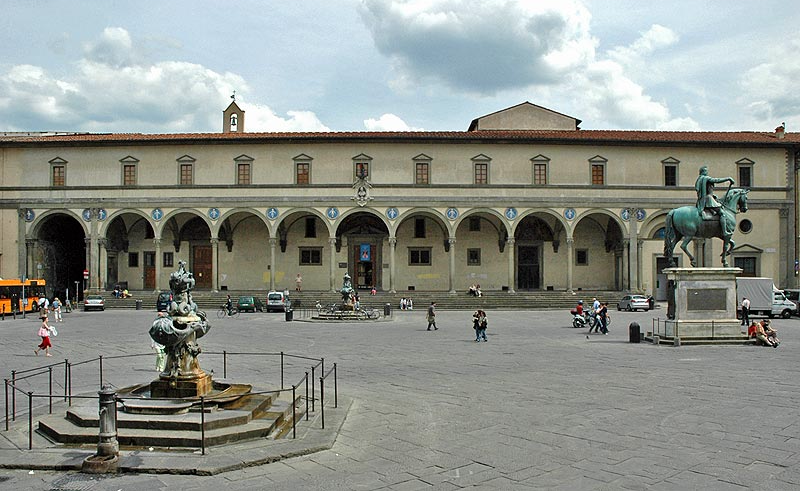
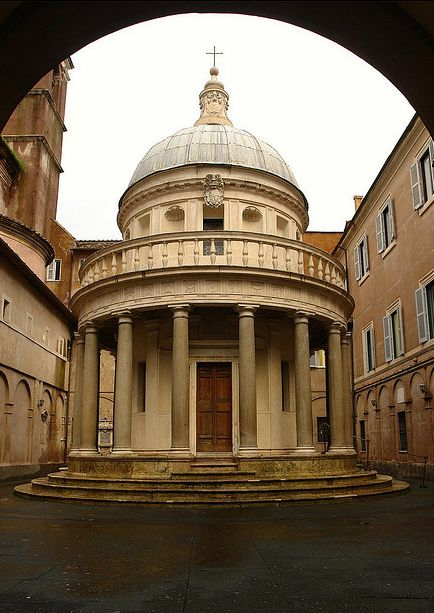 The austere Tuscan Doric[7] façade of Donato Bramante’s (1444-1514) Tempietto San Pietro[8] in Montorio (1502) symbolized the beginning of the early 16thcentury High Renaissance in Rome.
The austere Tuscan Doric[7] façade of Donato Bramante’s (1444-1514) Tempietto San Pietro[8] in Montorio (1502) symbolized the beginning of the early 16thcentury High Renaissance in Rome.
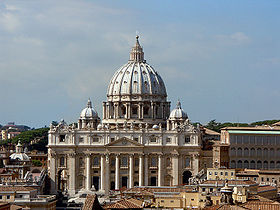 The Italian Renaissance is assumed to have achieved the highest degree of perfection at that time. In 1505 Pope[9] Julius II decided to demolish Old St. Peter’s and to build St. Peter’s Cathedral, the work of many architects, beginning with Bramante, whose ground plan[10] was later changed from a Greek cross to a Latin cross. St. Peter’s Cathedral is the largest church in the high Christian world. It has 29 altars in addition to the high altar, interior length 187 m., width at front, 26,5 m., length of transept, 137 m. The dome (diameter, 42 m., height, 123 m. to the top of the lantern) was built by Michelangelo.
The Italian Renaissance is assumed to have achieved the highest degree of perfection at that time. In 1505 Pope[9] Julius II decided to demolish Old St. Peter’s and to build St. Peter’s Cathedral, the work of many architects, beginning with Bramante, whose ground plan[10] was later changed from a Greek cross to a Latin cross. St. Peter’s Cathedral is the largest church in the high Christian world. It has 29 altars in addition to the high altar, interior length 187 m., width at front, 26,5 m., length of transept, 137 m. The dome (diameter, 42 m., height, 123 m. to the top of the lantern) was built by Michelangelo.
